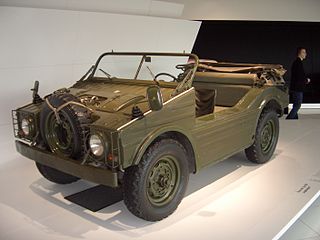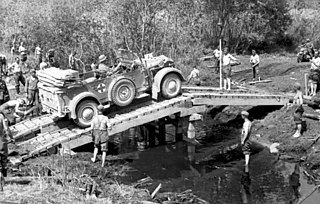
Volkswagen is a German automobile manufacturer headquartered in Wolfsburg, Lower Saxony, Germany. Founded in 1937 by the German Labour Front under the Nazi Party and revived into the global brand it is known as today post World War II by the British Army officer Ivan Hirst, it is known for the iconic Beetle and serves as the flagship brand of the Volkswagen Group, the largest automotive manufacturer by worldwide sales in 2016 and 2017. The group's biggest market is in China, which delivers 40 percent of its sales and profits. Its name is derived from the German-language terms Volk and Wagen, translating to "people's car" when combined.

Ferdinand Porsche was a German-Bohemian automotive engineer and founder of the Porsche AG. He is best known for creating the first gasoline–electric hybrid vehicle (Lohner–Porsche), the Volkswagen Beetle, the Auto Union racing cars, the Mercedes-Benz SS/SSK, and several other important developments and Porsche automobiles.

Tatra is a Czech vehicle manufacturer from Kopřivnice. It is owned by the TATRA TRUCKS a.s. company, and it is the third oldest company in the world producing motor vehicles with an unbroken history. The company was founded in 1850 as Ignatz Schustala & Cie. In 1890 the company became a joint-stock company and was renamed the Nesselsdorfer Wagenbau-Fabriksgesellschaft. In 1897, the Nesselsdorfer Wagenbau-Fabriksgesellschaft produced the Präsident, which was the first factory-produced automobile with a petrol engine to be made in Central and Eastern Europe. In 1918, the company was renamed Kopřivnická vozovka a.s., and in 1919 it changed from the Nesselsdorfer marque to the Tatra badge, named after the nearby Tatra Mountains on the Czechoslovak-Polish border.

The Volkswagen Type 82 Kübelwagen, or simply Kübel, contractions of the original German word Kübelsitzwagen, is a military light utility vehicle designed by Ferdinand Porsche and built by Volkswagen during World War II for use by the Nazi German military. Based heavily on the Volkswagen Beetle, it was prototyped and first deployed in Poland as the Type 62, but following improvements entered full-scale production as the Type 82. Several derivative models, such as the Kommandeurswagen, were also built in hundreds, or in dozens.

The Volkswagen Schwimmwagen is a light four-wheel drive amphibious car, used extensively by German ground forces during the Second World War. With over 15,000 units built, the Schwimmwagen is the most-produced amphibious car in history.

SEAT S.A. is a Spanish car manufacturer, that sells its vehicles under the SEAT and Cupra brands. Founded on 9 May 1950, it was created as a joint venture between Spain's government-owned Instituto Nacional de Industria (INI), which held a majority stake, Spanish private banks, and Fiat. After being listed as an independent automaker for 36 years, the Spanish government sold SEAT to the Volkswagen Group in 1986, and it remains a fully owned subsidiary of the Group.

Volkswagen Group China is a division of the German automotive concern Volkswagen Group in the People's Republic of China.

The Volkswagen Type 181 is a two-wheel drive, four-door, convertible, manufactured and marketed by Volkswagen from 1968 until 1983. Originally developed for the West German Army, the Type 181 also entered the civilian market as the Kurierwagen in West Germany, the Trekker in the United Kingdom, the Thing in the United States (1973–74), the Safari in Mexico and South America, and Pescaccia in Italy. Civilian sales ended after model year 1980.

The Willys MB and the Ford GPW, both formally called the U.S. Army Truck, 1⁄4‑ton, 4×4, Command Reconnaissance, commonly known as the Willys Jeep, Jeep, or jeep, and sometimes referred to by its Standard Army vehicle supply nr. G-503, were highly successful American off-road capable, light military utility vehicles. Well over 600,000 were built to a single standardized design, for the United States and the Allied forces in World War II, from 1941 until 1945. This also made it the world's first mass-produced four-wheel-drive car, built in six-figure numbers.

The Volkswagen Country Buggy is a small utility vehicle designed and built by Volkswagen in Australia. It used parts from the existing Type 1 and Type 2. Production ran from 1967 to 1968. A derivative of the Country Buggy called the Sakbayan was built in the Philippines for several years until 1980.

The UAZ-469 is an off-road military light utility vehicle manufactured by UAZ. It was used by Soviet and other Warsaw Pact armed forces, as well as paramilitary units in Eastern Bloc countries. In the Soviet Union, it also saw widespread service in state organizations that needed a robust and durable off-road vehicle. Standard military versions included seating for seven personnel.

The Ford GPA "Seep", with supply catalog number G504, was an amphibious version of the World War II Ford GPW jeep.

The GAZ-46, army designation MAV, is a Soviet-made light four-wheel drive amphibious military vehicle that entered service in the 1950s and has been used by many Eastern Bloc allied forces since.

The Porsche 597Jagdwagen is a light military vehicle, designed to fill the same general role as the Jeep, Kübelwagen and Land-Rover.

Military light utility vehicle, or simply light utility vehicle (LUV), is a term used for the lightest weight class military vehicle category. A Jeep-like four-wheel drive vehicle for military use by definition lighter than other military trucks and vehicles, inherently compact and usually with light or no armour, with short body overhangs for nimble all-terrain mobility, and frequently around 4-passenger capacity.

The Dodge WC series is a prolific range of light 4WD and medium 6WD military utility trucks, produced by Chrysler under the Dodge and Fargo marques during World War II. Together with the 1⁄4-ton jeeps produced by Willys and Ford, the Dodge 1⁄2‑ton G-505 and 3⁄4‑ton G-502 trucks made up nearly all of the light 4WD trucks supplied to the U.S. military in WWII – with Dodge contributing some 337,500 4WD units.

The Volkswagen Type 183, more commonly known as the Iltis, is a military vehicle built by Volkswagen for use by the German military. The Iltis was formerly built under licence in Canada by Bombardier Inc.

Einheits-Pkw der Wehrmacht – literally: "standard passenger motor-car of the Wehrmacht" – was the Nazi German plan for a new, multi-purpose fleet of all wheel drive off-road vehicles, based on just three uniform chassis, specifically designed and built for the Wehrmacht. The plan was formulated in 1934, and vehicles were built from 1936 to 1943.

The Trippel SG 6 was a Schwimmwagen developed in the 1930s and used by the German ground forces during the Second World War.
Roughly 720,000 cars per year are being sold in Nigeria every year. Only ca. 140.000 of them have been built domestically.




















